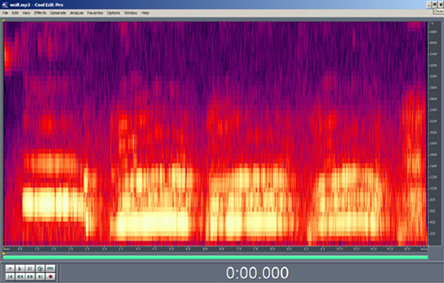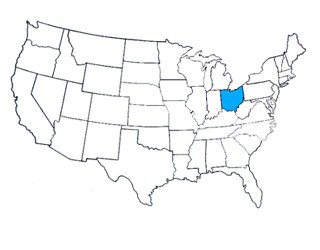This information was originally posted on my website about a year and a half ago.
When
THE BLOGSQUATCHER started his blog this was the topic of one of his earlier posts. So you may want to check out this information also over on his blog for Thursday, October 11, 2007 titled:
The voice of bigfoot? The Illinois Howl ---------------------------------------------------------------------------------
The Illinois Howl This post will attempt to answer some of the following questions:
What is the Illinois Howl?
What animal is making these vocalizations?
What are its characteristics?
What does it sound like compared to other animals?
What does it look like graphically compared to other animals?
Why am I wasting my time on something so obvious?
What is the Illinois Howl?The Illinois Howl is the vocalizations of presently an unseen and unknown animal. They were first recorded on the 4th of April, 2006. It was recorded five times that spring. I record nature sounds every night. The following five clips have been cleaned up to eliminate rumbling and hiss.
05.24.2006 Illinois HowlThis was recorded at 04:14 in the morning.
05.18.2006 Illinois HowlThis was recorded at 01:30 in the morning.
04.12.2006 Illinois HowlThis was recorded at 11:58 in the evening.
04.07.2006 Illinois HowlThis was recorded at 4:45 in the morning.
04.04.2006 Illinois HowlThis was recorded at 3:45 in the morning.
The complete series of recorded howls can be found at:
Illinois Howl Recordings
What animal is making these vocalizations?There are many opinions as to the origins of these sounds. Opinions range from coyote, coy-dog, dog, wolf, fox, bigfoot, cow.
As an attempt to get an answer I posted this question and a poll on many of the outdoor forums on the internet. These discussions can be found at:
Unusual Howl - 24 Hour Campfire What Do You Think Of This One? - Bigfoot Forums What Kind Of Howl Is This?? - Bigfoot Forums What Animal Do You Think This Is? - Bigfoot Forums Unusual Howl - Graybeards Outdoors ForumWhat Animal Do You Think This Is? - Graybeards OutdoorsUnusual Howl - Jesses Hunting & Outdoors (JHO) Forum Unusual Howl - Marlinowners ForumsWhat kind of howl is this? - Rimfirecentral Unusual Illinois Howl - Shooters Forum Unusual Howl - US Hunting Forums What are its characteristics?On the five recordings it exhibits several traits that are discernible on all five. The howl starts out as a low volume sound that seems like it is just clearing its throat. It then delivers three somewhat equal volume howls. The second and third howl are spaced a little bit further apart than the first and second howl. The waveform in Cool Edit 2 Pro looks like -

DB Donlon has done extensive research on this sound and has written the following analysis:
Stan's sound has a main frequency of 689Hz and a fundamental of 344Hz, according to SoundRuler.
(SoundRuler is a free application, now several years old (a new version is promised this year) that does have limitations. I think it was made for birders, for instance, and may therefore be based on assumptions that aren't so good for large mammals.)
In SoundForge, a completely different program (that costs money) you can look at prettier sonograms. I can also watch the PowerGraph in real time, and see where all the power of the call is going. By looking at the sounds in the SoundForge Powergraph window, I can see how the frequencies are interrelating. For instance, Stan's howl gets "dirty" several times, where the voice is no longer producing a clear note, but instead is moving into the growly "noise" range. We know that dogs can do that, but so can any other mammal that has enough voice, including man, and anything that roars. The dog file I have does a little of it at the beginning of its call too. So there is a similarity between them. But they do not match in where they use this modulation of the sound. You might not expect them to, but then we also all know the classic wolf call, and how that modulates. It's a classic because wolves do it, rather than using a completely chaotic repretoir of noises such that we can detect no pattern. This is not a major point, but so far as it goes, Stan's sound isn't matching what other dog calls I can find do in the way that it modulates its call. So it sounds like what a dog can do, but it sounds different from my dog examples. Make sense?
Here's another difference. You can see that both calls are very close to the microphone, as nature sounds go, because the high end information is well preserved above the noise-floor. I limited my view to around 4.2KHz so that I could see the fine details of what was going on in there, and both sounds gave me numbers in the 3.8-3.9KHz range. So insofar as distance from microphone goes, it appears there isn't a difference that makes a distinction. But the dog sound looks absolutely normal, hitting almost all its harmonics on the way up. These are the rough numbers in Hz:
Dog Howl:
420 648 850 1073 1269 1508 1720 2521 2997 3260 3417 3895
The fundamental frequency is at about 220Hz here, so every number above should be a multiple of 220. The differences are because of measurement errors and the fact we are using software that wasn't designed to do exactly what we're asking it to do. I have to hold the mouse cursor and read the number, write it down, etc. So 850 ought to be 860, or the fundamental was perhaps closer to the 215Hz that SoundRuler gave us (though SoundRuler was giving us the average, and I'm taking a snapshot of the "moving" sound, so we can expect this kind of difference).
Stan's sound is a little different.
Illinois Howl:
xxx 662 971 1309 xxxx 1960 2270 2615 xxxx xxxx xxxx 3936
There are gaps, and the numbers don't match the fundamental as closely as the dog's sound did.
These are two important points, I think, to bear in mind. The sound sounds weird to us for these reasons -- it doesn't conform to what we normally expect. I can explain the fact that the numbers don't match the fundamental, which ought to be around 340Hz according to SoundRuler, because the noise this animal is making is dirtier than the sound the dog is making. It's much more like a roar than the dog's howl is, even at those points where it sounds relatively clear. What this means is that when I move my cursor looking for the peak, I have a lot of wiggle room. In figurative words, I choose the highest relative peak on a plateau. The frequency looks like a plateau because the animal was introducing distortion into its voice -- kind of like a guitar with a stomp box. Use enough of that distortion and you just get a noisey roar. Use a little, and it sounds cool. I don't know enough about dogs and their barks to say that dogs don't do this sometimes in exactly this way, but I don't have any sound files of them doing it.
About the gaps I am just confused. I can explain the upper gaps away due to distance, although that peak at 3.9KHz was a good one. I expected the other peaks to be there. Maybe if I focused down in on those frequencies, I'd find them, but then we'd still have to explain why they had been so damped when other frequencies hadn't. I checked some of Stan's other files of other animals in the same location, and it doesn't appear that there is any environmental reason for it. And I noted the same kind of gapping in the other files with this same animal doing its call. I don't know what it means, but I am entertaining the idea that it means something.. The gap where the 1.6KHz peak should be is a strange one.
So while I won't come out and say, "Yes, this is it, this is a bigfoot call," I'm not writing these sounds off. I will say that I doubt this call was made by a coyote, as has been hypothesized elsewhere, or any other mammal smaller than a large dog. All the coyote calls I have have a fundamental at around 600Hz, much too high to be the Illinois Howler.
If it's a dog or a wolf, we ought to be able to find matches for the Illinois Howl that have already been recorded, or get new clean recordings of the howls with the animals under observation.
What does it sound like compared to other animals?For comparison let's look at the Illinois Howl and three other known animals.
Click on each link for the mp3 of each animal:>
Belle, my Karelian Bear Dog Coyote (Canis latrans)Illinois Howl Wolf (Canis lupus)What does it look like graphically compared to other animals?Visually each animals howl is seen in the waveform view. I have used Adobe Audition 2.0 as the sound editor:
Belle, my Karelian Bear Dog

Coyote (Canis latrans)

Illinois Howl

Wolf (Canis lupus)

Then each animal's howl is seen in the spectral view:
Belle, my Karelian Bear Dog

Coyote (Canis latrans)

Illinois Howl

Wolf (Canis lupus)
 Why am I wasting my time on something so obvious?
Why am I wasting my time on something so obvious? Many people have stated that it is quite obvious that the Illinois Howl is nothing other than a coyote or dog, certainly canine. They wonder why I would be so naive to suggest that this sound is anything else. On the other side of the coin are those people who have told me that they have spent a great deal of time in the woods and maintain that it is impossible to be a coyote.
My original interest in the sounds in the woods and along the creek behind my home started last spring. On the 23rd of May, 2005 I went out into my backyard to check on my dog, Belle. She had been barking for some time and would just not settle down. So I grabbed my 3rd gen night vision and proceeded to take her toward the creek and show her where I had seen deer bedding down. As I reached the edge of the yard I heard what sounded like a very large roar coming from the creek bottom. The call was very deep and full. The sound lasted for about 15 seconds and then all was quiet. It appeared to be coming from something with a huge chest. The call had a somewhat human quality to it. I went into the house to ask my wife to come and listen. Nothing else was heard. The dog settled down and did not bark again that evening.
Since that time I have been placing my audio recorder down near the creek or on the hill above it. Although this is Central Illinois we have a large deer population. Other wildlife seen along this creek include several sightings of mountain lion and bobcat. We also have a sizable population of coyotes. About 3 miles to the east of me is a state park with a large lake and lots of marshy areas. And about 10 miles north of our home the creek flows into the South Fork of the Sangamon River.
Will this riddle of the Illinois Howl ever be solved. Yes, of course!















